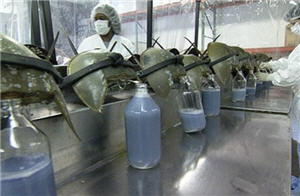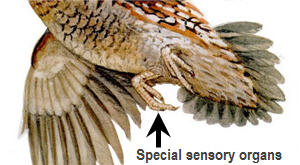
Horseshoe Crabs
 |
| Harvesters take a percent of blood from each horeshoe crab then crabs are returned to the water, where their blood volume rebounds in a few months. Photo credit: PBS. |
The blood of horseshoe crabs turns blue when exposed to air. A protein in their blood can be used to identify the presence of bacteria and toxins on medical instruments. Vaccines, injectable drugs, intravenous solutions, and implantable medical devices, both for humans and animals, are quality checked for safety using a test that comes from the blood of horseshoe crabs.
![]() Read How horseshoe crab blood protects public health
Read How horseshoe crab blood protects public health
Minnow Family
The minnow family is made up of 1,600 different species, one of the largest on Earth. Some 48 species of minnows occur in New York state. The abundance of minnows may be attributed to three factors: they can occupy a great variety of habitats, most species require a relatively short period of time to reach breeding age, and a large number of minnows can occupy a small space and find sufficient food and shelter because of their small size
![]() Read The Minnow Family in North America
Read The Minnow Family in North America
Bobwhite Quail
 |
| Special sensory organs in the bobwhite quail help it detect vibrations in the ground. Photo credit: Field & Stream Sportsman's Notebook |
Special sensory organs in the legs of bobwhite quail help detect vibrations in the ground made by an approaching predator. Bobwhites from coveys of 10 to 15 birds for protection from both predators and the weather. In the winter these densly packed groups conserve body heat. The birds will rotate from the inside to the outside of the circle to distribute heat evenly. - Jack Larson, page 52 Field & Stream, Sportsman's Notebook
Deer & Other Nocturnal Animals
You may have wondered how do deer and other nocturnal animals see at night? Answer, nocturnal animals tend to have proportionally bigger eyes than humans do and their pupils tend to open more widely in low light. Also, they have a thin membrane of tendon-like tissue at the rear of the eyeball that bounces light through the eye’s nerve layer twice. This greatly enhances their ability to see in dim conditions. It is also what causes the glowing green orbs that you see reflecting in your headlights.
![]() Read: Top Ten Cool Ways Animals See in the Dark
Read: Top Ten Cool Ways Animals See in the Dark
Ancient Salmon
 |
| A saber-toothed salmon, as depicted by artist Ray Troll. The mural is part of the University of Oregon Museum of Natural and Cultural History. Photo credit: University of Oregon |
Fossil records from more than 5 million years ago show that the Sabertooth Salmon in the Pacific Ocean once grew to more than 6 feet long and weighed over 250 pounds.
![]() Read: Sabertooth Salmon
Read: Sabertooth Salmon
If you didn’t know, now you do.
By Larry Whiteley, Host of the award winning
Outdoor World Radio
- 5850 views

